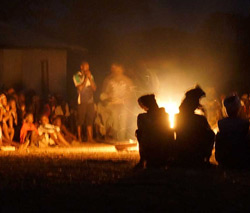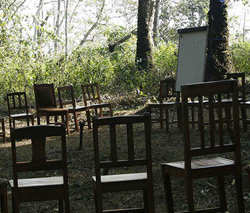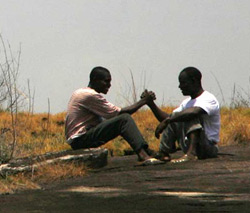Libby’s Story …
A college course on the theory and practice of nonviolence during my junior year at Williams College first gave my activism its shape. Absorbed as I was by the stories of nonviolent action, leaders and theory we were studying, the process of the class captured me, too. It was completely student-run, with students having organized the course and the syllabus, and students taking turns facilitating the class sessions. There were very few if any externally enforced requirements, and my “grade” was a thoughtful, insightful written evaluation by my peers. And I had never worked harder or learned more. The lesson was profound.
Finding my work in this world has meant forging a way of working consistent with the values of the work itself, as with the process I first experienced in that class.
The world changed rapidly as I did my graduate work in international relations. The Cold War was ending. Violent conflict became more localized. Mass movements of nonviolent, empowered citizens grew in frequency and impact, and civil society claimed more presence and power in the global conversation. I became a professor of political science at a time when ordinary people all over the world had their lives disrupted by both global issues and by localized conflict and civil war. But the mechanisms for solving these conflicts and rebuilding societies were still steeped in the Westphalian notion of international politics being enacted primarily by important men sitting around a table.
I knew that ordinary people⎯those most impacted by conflicts themselves⎯if given the space and the opportunity, could have tremendous, positive social impact. But in the books I read, in the events I observed, and in the theories I taught, that space and opportunity were lacking.
The most positive, hopeful work I saw in the growing field of peacebuilding was coming from faith communities. As a committed Christian Scientist teaching at a college for Christian Scientists, I embraced the idea of mobilizing religious resources for peace. I met fellow Christian Scientist Cynthia Sampson, a pioneer in the field of religion and peacebuilding then working at Eastern Mennonite University. We gathered friends, colleagues and former students and created an organization dedicated to examining, developing and living an approach to conflict resolution springing more intentionally from our study and practice of Christian Science: Peace Discovery Initiatives, or PDI.
With PDI, I developed and ran conflict resolution training and practice programs in corporate, educational, and congregational settings, and we convened working groups and conferences. While PDI only lasted a few years, it brought positive approaches to peacebuilding into greater prominence and connected me with a vibrant global community of interfaith peacebuilders.
And then my father, a successful land developer in Florida, took his company public. Company stock that had been in my name as part of an abstract, far-in-the-future estate planning tool became liquid, and suddenly I had access to significant financial resources. With these resources, I saw I had an opportunity so breathtaking it was more of an obligation. I could help bring into being what I thought the world most needed. I had the resources to do the work I most wanted to do: catalyze peace.
… becomes the story of Catalyst for Peace.
And so, in 2003, I established the Catalyst Fund. But I found I couldn’t follow the typical foundation pattern and simply fund the work in a way that was completely separate from the practice of that work. I renamed us Catalyst for Peace—and I went to work.
I wanted to find ways to unleash the potential of ordinary people, men and women. I wanted ordinary people not only to be considered in international conflict resolution, but to lead the way. I wanted to create space for the people most impacted by conflicts, in the context of the communities where they live, to have the central place in resolving those conflicts.
I have always been one to believe that the best way to learn to do something is simply to do it. And I know that learning-in-practice takes time. So I figured we would need at least five years of practice to come into clarity and focus on how Catalyst for Peace was meant to make its unique contribution to the world. Our first five years was not only like a vital learning lab for me individually and organizationally, it also proved to be remarkably rich in its contributions to the world.
In its first five years, Catalyst for Peace:
- convened grassroots Israeli and Palestinian peacemakers with American policymakers, and then built a platform for similar work to go forward in more systematic ways. In 2003 we established the Center for World Religions, Diplomacy and Conflict Resolution at George Mason University’s Institute for Conflict Analysis and Resolution to find ways to bring positive dimensions of religion onto the international stage and counter the growing presence of religious extremism;
- partnered with the United Religions Initiative in training teams of courageous peacebuilders from southern India, Northern Uganda, Ethiopia, the Philippines, and North America to engage in locally-rooted, faith-based peacebuilding, and to build on that to create and strengthen organization-wide interfaith peacebuilding capacity.
- developed the Voice to Vision research and practice fellowship with journalist and photographer Sara Terry, to provide young women studying peacebuilding with experience in the field while cultivating the sensibility and approach that makes a true catalyst for peace; and
- shared powerful stories of peace that the world needed to hear through Seeing Africa, a program that sought out, recorded and shared the stories of forgiveness and reconciliation in different post-war African settings.
But the most complete realization of the work I hoped to do was yet to come.
In 2007, Voice to Vision began a one-month field stay in Sierra Leone, documenting amazing examples of forgiveness after the 11-year civil war. It was on this trip that Sara Terry met John Caulker, a powerful human rights advocate, community leader and grassroots peacebuilder trying to achieve his vision of true justice and peace for his country: one that would be led at the community level by the people most impacted by the war itself, drawing on the culture and tradition of Sierra Leone, providing ordinary people a chance to tell their stories, apologize, and forgive. Sara knew she had to introduce John to me.
John and I spoke on the phone then met in person a few weeks later in October, when he was in the U.S. for a human rights fellowship at Columbia University. We decided to work together almost immediately. We articulated our vision for a pilot program to do the work he knew was needed in his country, convened colleagues from Sierra Leone and the U.S. to shape a plan, and made the decision to document this work in film. In December 2007, CFP helped to launch Fambul Tok into the world – both the program and the film.
And I knew the hard work of creating the space for community-owned and led peacebuilding efforts like Fambul Tok was the work I most wanted to do in the world, and in fact the very work I had been called to do in the world.
Walking beside Fambul Tok since 2007, CFP has lived, practiced and proven our vision. We have pioneered transformative insider-outsider, funder-recipient, and practitioner-storyteller, relationships to support large scale, locally owned and led peacebuilding, reconciliation, economic development, and now even public health processes.
And we can’t wait to grow the conversation. To share what we’ve learned. To learn from others. And to work together to expand practice that puts communities in the center, and that supports and works equally well for all parties in the complex system of peace.
Home page and current page banner image (c) Sara Terry for Catalyst for Peace





